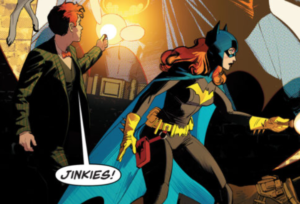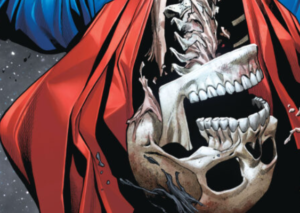REVIEW: Superman: Space Age #1
Russell and Allred give Superman the historical treatment to juxtapose humanity’s bleakest time to DC comics’ bleakest in a way that keeps the light in our hands rather than at the end of the tunnel in Superman: Space Age #1.
Superman: Space Age #1 is finally here and this month keeps on giving when it comes to great Multiversal Superman stories. Just last week, we were treated to King and Burnham’s Superman: World Without a Justice League story.
Now, after much hype since the announcement, Mark Russell and Mike Allred’s Superman: Space Age hits the shelves as one of the most recommended Superman reads of the year – and it’s just the first book. Our article about the series’ announcement details the two great variants that Nick Derrington and Steve Rude did for this issue.


It was no mystery that Mark Russell had a retro setting in mind for Space Age. Some of the panels that Allred teased also seemed to hint at a Cold War setting. And, that is exactly where our story begins. Mild-mannered Clark Kent has been living a quiet life with Ma and Pa Kent, having crashed landed in their care as an infant sometime after WWII in the 40s.
As a teen, a manly looking one at that, he has yet to leave the farm and even float the idea of becoming Superman. His powers are no mystery, but the rookie has no idea how to apply them. Doomsday, not the character but the situation itself, is explored as the main theme here through two main conflicts – the impending Crisis on Infinite Earths set to take place in 20 years and the United States and the Soviet Union being on edge with shaking fingers over the nuclear launch buttons during the height of the Cold War in the 60s.
The world needs a Superman more than ever, but the suit truly has power beyond those who just wear it. Young Clark isn’t so sure he is ready to bare it just yet despite the urging of his Kryptonian father Jor-El. Clark’s story here is everything everyone is familiar with, ripe with homages and scenes from the most told origin story across media and pop culture. What makes it unique here is the setting and climate, which adds a whole new motivation as to why Clark needs to first become Superman.
He’s not the only one with motivation to save the world. Familiar faces like Bruce Wayne and Lex Luthor are both in bids for military contracts, while Hal Jordan tries to maintain a top gun status for the air force. You can absolutely imagine the gear Bruce has Lucius Fox and Wayne Enterprise are cooking up to make soldiers and vehicles more defensive and a deter to enemies rather than extermination. Lex Corp, meanwhile, is more so focused on planning for the worst-case scenarios with specialised shelters, and he has a nefarious scheme to make sure those sales are met and his new world is born.
There are tons of not just good comic moments, but great writing and character moments that nearly transcend the medium thanks to Russell’s writing and story treatment. The entire issue is set to journal entries from Clark. The journal isn’t the big impressive one he has in the Fortress of Solitude, but a small humble one his mom gave him as a gift – every writer relates to that. This isn’t the journal of a hero, but of a good son reflecting on what his fathers told him about living and how they and his life at large connect. Of course, Clark also makes for a great narrator.
Lois Lane does some writing of her own as well. Doing what she does best, she writes a piece on JFK, who had just been assassinated, along with an interview with the First Lady. Russell uses this historical event, presumably one of many in the story, to uniquely contextualise both Superman’s origin and Lois’. This is the piece that gets her hired by the male-dominated Daily Planet in the first place. Since this is the past of the story, we have yet to get any Superman and Lois moments – but the prologue with the Kents in the Fortress during the Crisis offers a really sweet moment.
Historical events are also applied to other characters in a way that doesn’t make them just relevant, but also fascinating. Jonathan Kent was a soldier in the Pacific during the War while Sam Lane was in Europe. These harrowing war stories are used to realistically explore hope against darkness and how you can always hold onto something in order to persevere. There is a little number in there about how the universe has a way of looking out for you too. These kinds of stories have to be looked at twice to fully connect them. Several other historical and political events of the 60s are used to explore this theme set to either Clark or Lois’ lamentations. For obvious reasons, these two are some of the most perfect characters to do this.
One last thing to love about Russell’s writing is his subtle humor. Whether it’s wordplay, physical comedy, or acknowledging the silly – he executes well in a comic setting. Superman hitting a bird and getting thrown off course as a beginner flyer is one such example. Another great funny moment was when Pariah told him that insects would conquer America in the near future and the Beatles show up on the TV in the background as if on cue.
The only other thing to talk about here is the art. Mike Allred’s bold lines actually give the whole comic a retro feel – almost like a comic from the Stan Lee and Jack Kirby days would. This truly fits the time period and setting. Mike’s wife, Laura, is of the colors in this series. It’s really sweet how husband and wife are also an artist/colorist creative team. While the title would suggest we’d see some serious cosmic art, the Allreds have illustrated a very down-to-Earth story.
When history and even politics are applied to Superman, the result can be appealing. We have stories like Red Son and characters like Calvin Ellis, for example. Russell and Allred give Superman the historical treatment to juxtapose humanity’s bleakest time to DC comics’ bleakest in a way that keeps the light in our hands rather than at the end of the tunnel in Superman: Space Age #1.








1 thought on “REVIEW: Superman: Space Age #1”